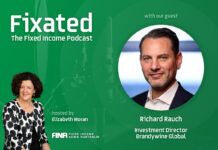
A major danger of assessing sustainable investing is to simplify circumstances deserving of nuance. This is particularly the case for emerging sovereign debt markets, where debt levels and GDP income show only a fraction of the story.
No country can achieve a sustainable growth pattern or an inclusive economic outcome without first ensuring debt sustainability. Debt sustainability is core to managing these outcomes.
The World Bank warned the market of the shortcomings of sustainability models in a paper titled ‘Demystifying Sovereign ESG’ last year, which showed how many ESG frameworks tend to be overly correlated to country wealth. Such models are regressive and antithetical to sustainable investment in emerging markets. This is why we, at T. Rowe Price, do the ground-up work ourselves. We de-anchor a country’s rating from its income, and intensely focus on its economic and political institutions and whether the value they create is extractive—benefiting a small elite or inclusive—benefiting the population at large.
To start, a country’s debt sustainability requires market access –can that country raise funds from the market through debt issuance. Few countries, if any, can generate enough tax revenue to pay back their debt without refinancing it. So, to do that, the country must be able to grow out of its debt and assure the market that they will maintain credible policy. This is no easy task.
Also read: Listening To The Wind Of Change
Japan has one of the deepest and highest quality sovereign bond markets in the world and is solvent despite its debt to GDP being 300%. On the other hand, Mexico’s sovereign debt crisis of the 90s occurred with a national debt to GDP of just 30%. Why? Market confidence in those nations refinancing their debts was not the same, be it through a cycle or crises.
Market access and confidence are inextricably linked, ‘anchored’ by key market components and mechanisms. When all anchors are lost therein rises the very high probability of debt distress and social tension. We focus on four market confidence anchors:
- Fiscal, the growth of the economy relative to the interest payments. The original sin for many of these countries is a lack of tax collection, or even tax avoidance, the inability to garner economic output into government receipts.
- External, how a country interacts with the world through its balance of payments and that ties into reserve management and monetary policy.
- Political Climate and Institutional Capacity, that ultimately police outcomes and put guard rails around human judgment.
- Contingent assets and liabilities, the assets of a country being potentially sovereign wealth funds or natural resources, whereas liabilities stem from a banking sector crisis like in 2008 or maybe environmental costs related to climate change.
Not all anchors are weighted equally, however, with ESG factors deeply embedded in each playing a differing role, from an offense (pursuit) defense (avoidance) perspective.
It not uncommon for politics and institutions to bring down the entire interconnected system for a country. We’re seeing an example of this right now in the Mexican non-bank financial sector, which is going through a default cycle, paralleling those seen a number of developing countries. Many of these non-bank financial institutions are highly extractive, charging usury lending rates which stifle upward economic mobility for the population. Those businesses earn outsized profits on the backs of less educated consumers. They later likely become targets of regulation and, when in a credit squeeze like today, often default. So, avoiding lending to those businesses is a key value driver.
Conversely, even with oil above US$120 and resurgent energy prices around the world, renewable businesses in India have been some of the most resilient high yield corporate bonds, not just in emerging markets but globally.
We live in a grey world, we need to appreciate that sovereign nations, by definition, have very broad ESG footprints. There are extreme outliers where democracies have extractive economic institutions, versus autocratic governments which may stifle political voice, but have created institutions that have facilitated upward economic mobility. For example, despite China being in the center of many ESG debates, we’ve witnessed it preside over the greatest reduction of human poverty in history.
It’s also important to underscore directionality – the positive momentum relative to the recent history of the country. Take Angola for an example, the country has gone from debt distress towards debt sustainability supported by orthodox macro-economic policy and the implementation of an IMF reform program, upgrading its credit rating from triple C to a single B.
At the end of the day, for a country to improve its social and environmental conditions, it must pay for them, so debt sustainability is the fundamental building blocks for any investment premise.
Simplistic assumptions made about entire countries or sectors can clog the arteries of global finance. Complexity is deserving of nuance, so we approach country risk with a scalpel not a hammer.

































